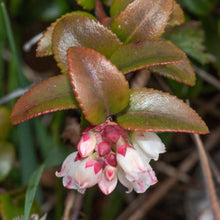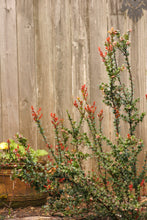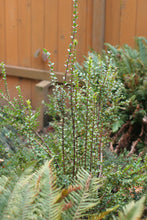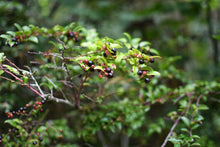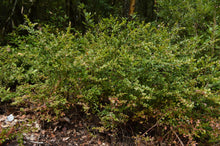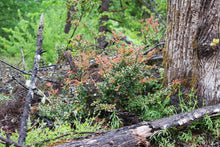
Vaccinium ovatum
Evergreen huckleberry is a medium-sized evergreen shrub that is ornamental, versatile and low-maintenance in NW native gardens. During the growing season, its new growth emerges in attractive hues of reds and bronze then shifts to glossy deep green as it ages. These year-round leaves are complimented by clusters of urn-shaped white and pink flowers that appear to be decadently dripping from the branch tips and attract hummingbirds and insect pollinators. Flowers mature into edible fruits that sweeten with the first light freeze and are delicious in pies, jams or straight into your mouth.
- Plant type/canopy layer: evergreen, perennial, med/large shrub
- Size at maturity: 4-8' tall, 3-6' wide
- Light requirements: full sun to full shade
- Moisture requirements: moist soil, prefers well-drained
- Bloom time: March - July (April - July in the Portland Metro area)
- Growth rate/ease: slow growing, easy to grow
- Wildlife support: flowers attract and provide nectar to hummingbirds, adult butterflies, bees and other insect pollinators; overall plant is a caterpillar host plant and larval food source; berries are eaten by many songbirds and mammals including chipmunks and black bears; foliage is a browsing food source for deer, elk, rabbits, and grouse and provides shelter for birds and small mammals
- Native habitat/range: commonly grows along the edges of beaches and along the edges and in openings of second growth conifer forests, at low elevations from the west side of the Cascade Mountains to the coast, from British Columbia in the north to California in the south. Portland Plant List - yes.
- Special features & uses: wildlife and hummingbird favorite; edible - berries are a valuable traditional food for many indigenous people in the Pacific Northwest fresh or dried into cakes; foliage is used in the floral industry; medicinal; landscape uses include pollinator gardens, woodland gardens, erosion control, hedgerows and screens
Gardening with Evergreen Huckleberry: This shrub is popular in naturescapes because it's versatile, attractive, highly-functional and a wildlife favorite. It can thrive in nearly all light conditions, but in the Willamette Valley, it tends to prefer more shade, while on the coast it handles full sun with ease. Its form will vary depending on the light conditions provided; growing more dense in full shade and looser with more sun. Soils should be moist, well-drained and acidic soils. That said, it does tolerate summer drought impressively well, once established. It is slow-growing, but the payoff is worth the wait, especially in wildlife-friendly hedgerows and privacy screens.
Companion Plants: Evergreen huckleberry thrives in a wide range of habitats. In shadier areas, try it with California hazelnut (Corlyus cornuta ssp. californica), salal (Gaultheria shallon), snowberry (Symphoricarpos albus) and herbaceous cuties like small-flowered alumroot (Heuchera micrantha), Pacific waterleaf (Hydrophyllum tenuipes), vanillaleaf (Achlys triphylla), fairybells (Prosartes sp), candyflower (Claytonia sibirica) and/or piggyback plant (Tolmiea menziesii). In more open areas, consider Ponderosa pine (Pinus ponderosa), Douglas Fir (Pseudotsuga menziesii) and/or cascara (Frangula purshiana) in the overstory, shrubs such as red flowering currant (Ribes sanguineum), oceanspray (Holodiscus discolor), tall Oregon grape (Mahonia aquifolium) or red-stem ceanothus (Ceanothus sanguineus) and herbaceous plants such as fringecup (Tellima grandiflora), red columbine (Aquilegia formosa), Oregon iris (Iris tenax), celery-leaved lovage (Ligusticum apiifolium) and/or wild straberry (Fragaria virginiana).
Photo Credit 1 (flowers): © Don Loarie, some rights reserved (CC-BY)
Photo Credits 2 & 3 (in habitat garden): Karli Del Biondo, Beetles and Bees
Photo Credit 4 (leaves/flowers): © Michelle Norcéide, some rights reserved (CC-BY)
Photo Credit 5 (berries): Tara Lemezis, Tiny Seed Photography
Photo Credit 6 (mature habit): © David Anderson, some rights reserved (CC-BY)
Photo Credit 7 (in the forest): © elayc, some rights reserved (CC-BY)







